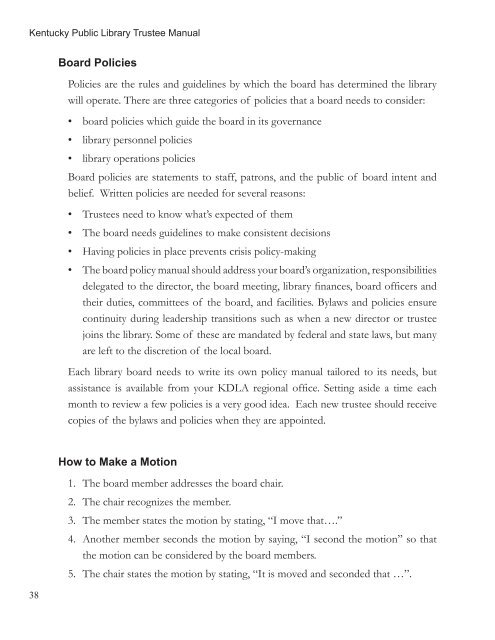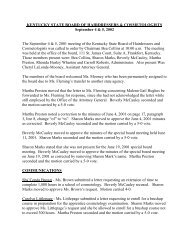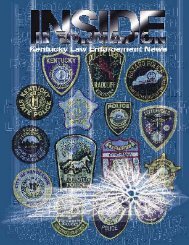Kentucky Public Library Trustee Manual - KDLA
Kentucky Public Library Trustee Manual - KDLA
Kentucky Public Library Trustee Manual - KDLA
You also want an ePaper? Increase the reach of your titles
YUMPU automatically turns print PDFs into web optimized ePapers that Google loves.
<strong>Kentucky</strong> <strong>Public</strong> <strong>Library</strong> <strong>Trustee</strong> <strong>Manual</strong><br />
38<br />
Board Policies<br />
Policies are the rules and guidelines by which the board has determined the library<br />
will operate. There are three categories of policies that a board needs to consider:<br />
•<br />
•<br />
•<br />
board policies which guide the board in its governance<br />
library personnel policies<br />
library operations policies<br />
Board policies are statements to staff, patrons, and the public of board intent and<br />
belief. Written policies are needed for several reasons:<br />
•<br />
•<br />
•<br />
•<br />
<strong>Trustee</strong>s need to know what’s expected of them<br />
The board needs guidelines to make consistent decisions<br />
Having policies in place prevents crisis policy-making<br />
The board policy manual should address your board’s organization, responsibilities<br />
delegated to the director, the board meeting, library finances, board officers and<br />
their duties, committees of the board, and facilities. Bylaws and policies ensure<br />
continuity during leadership transitions such as when a new director or trustee<br />
joins the library. Some of these are mandated by federal and state laws, but many<br />
are left to the discretion of the local board.<br />
Each library board needs to write its own policy manual tailored to its needs, but<br />
assistance is available from your <strong>KDLA</strong> regional office. Setting aside a time each<br />
month to review a few policies is a very good idea. Each new trustee should receive<br />
copies of the bylaws and policies when they are appointed.<br />
How to Make a Motion<br />
1.<br />
2.<br />
3.<br />
4.<br />
5.<br />
The board member addresses the board chair.<br />
The chair recognizes the member.<br />
The member states the motion by stating, “I move that….”<br />
Another member seconds the motion by saying, “I second the motion” so that<br />
the motion can be considered by the board members.<br />
The chair states the motion by stating, “It is moved and seconded that …”.













